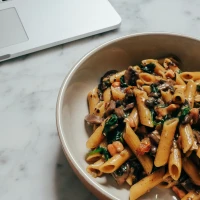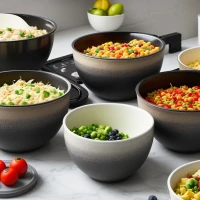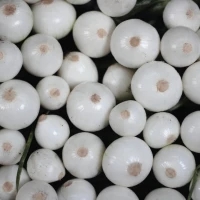In the age where the character and soul of home decor distinguish one space from the next, it’s no wonder that the once-overlooked dough bowl has made a resurgence as a versatile centerpiece. These rustic artifacts, steeped in history and palpable simplicity, are now taking center stage in modern homes, adorned with a tableau of ornate, functional, and captivating designs. Presenting not just a piece of eye-catching decor, dough bowls invite a sense of warmth and authenticity into any setting, embracing the current trend of bowl as bowl food presenter and on-trend aesthetic enhancer.
For those seeking to enrich their living quarters with a touch of timeless elegance, harnessing the earth-toned appeal of decorating dough bowls is a journey in breathing new life into these historical vessels. The charm of a well-decorated dough bowl lies in its understated allure, offering a canvas for creativity that can flawlessly align with the spectrum of home styles — from the minimalist to the bohemian, the contemporary to the traditional.
Embrace the rustic charm of dough bowls and follow our guide for turning this food vessel into an arresting decorative feature. Whether it’s the heart of your farmhouse table or the soul of your sleek sideboard, learn how to master the art of dough bowl decoration that whispers bucolic serenity into any nook of your home.
The Revival of the Dough Bowl in Home Decor
Dough bowls hail from a time when every kitchen tool had a story and a purpose shaped by hand and adversity. Their comeback is forging links between the past and the present, turning them into coveted items within the home decor space.
The Versatile Nature of Dough Bowls
Dough bowls were originally used for bread-making by many civilizations. Today, they serve not only as historical pieces but also as dynamic decor items. Their large, concave structure makes them perfect for showcasing a variety of objects and themes in your interior design.
Styling with Authenticity and Function
The raw, wooden texture of a dough bowl adds a natural element to decor, bringing the outdoors in. Furthering this connection to nature, many stylists and homeowners are now using dough bowls as centerpieces for not only visual appeal but also functional bowl food displays. This interplay of form and function is key to their revived popularity.
The Art of Decorating Dough Bowls
Decorating a dough bowl is an intimate process, one that allows for a personalized touch that can evolve with the seasons and occasions. Each ornamentation can be a reflection of one’s personal taste and home ambiance.
Seasonal Splendor
- Autumn: Fill your dough bowl with gourds, pine cones, and candles for a cozy, autumnal vibe.
- Winter: Laden with baubles, evergreen boughs, and twinkling lights, a dough bowl becomes a festive holiday statement.
- Spring: Acknowledging rebirth, a spring-themed bowl can display fresh blooms, pastel eggs, and sprouting bulbs.
- Summer: Sea shells, driftwood, and succulents in a dough bowl bring the essence of summer indoors.
Emphasizing Textures and Layers
Creating a multi-textural landscape within your dough bowl is key to elevating its look. Combine shiny and matte, rough and smooth, and vary the heights and depths for visual interest. The layering techniques can set apart a dough bowl that’s merely filled from one that tells a dynamic, tactile story.
A Showcase for World Flavors
With the upswing of interest in bowl food, dough bowls also offer an inventive way to present meals. Fill them with assortments of tapas, fruits, or artisan bread, bringing rustic elegance to every bite.
Step by Step: Curating Your Dough Bowl Display
Tackling the decoration of a dough bowl need not be an exercise in overwhelming choices. Below, we’ll walk through each step to ensure your dough bowl becomes a statement piece worthy of any magazine spread.
Choosing Your Base
Selecting Fillers and Foundation
- Sphagnum moss
- Burlap layers
- River stones
These foundational elements provide a bed upon which to build your design. They offer not just aesthetic merit but also practical composition, holding items in place and adding an extra dimension of texture.
Creating Harmony with Accents
Gathering Complementary Elements
- Forged iron elements: Adding industrial tones.
- Wooden spheres or twigs: Infusing an element of the natural world.
Elevating the Design with Featured Items
Using Signature Pieces
- Antique finds
- Handcrafted pottery
- Vintage books
These items serve as focal points, grabbing attention and punctuating the overall theme you wish to convey.
Maintenance and Care for Your Dough Bowl
While the aesthetics are paramount, the cherished status of the dough bowl as an heirloom insists on proper maintenance. Here are some tips:
Preserving the Wood
Cleaning and Conditioning
- Cleaning: A soft cloth and gentle cleaner are your best friends for keeping the wood pristine.
- Conditioning: Natural oils such as mineral oil help keep the wood supple and the bowl in use for years to come.
Frequently Asked Questions: Dough Bowl Decor
Can I use real food in my dough bowl?
Absolutely! Dough bowls offer a unique way to serve bowl food. Line them with food-safe paper or napkins to maintain cleanliness.
How can I adapt my dough bowl decor to different styles?
Versatility is the dough bowl’s middle name. Swap out items to match modern, industrial, or countrified decor themes with ease.
Where can I find a dough bowl?
Antique shops and online marketplaces are treasure troves for finding dough bowls. Alternatively, many boutique decor shops now stock reproduction pieces.
Conclusion: Crafting a Vignette of Time-Honored Tradition
With an understanding of the elements of design, a spark of creativity, and a collection of complementary pieces and accents, your decorating dough bowl can become a tapestry that weaves together both form and function. It can stand as an homage to rustic elegance and an invitation to explore the flavors and textures offered by the world of bowl food. Encased in the timeless grain patterns of a dough bowl, your home will radiate the warmth of tradition and the personality of its inhabitants, redefining what it means to craft a space that is not only seen but felt.










